- Home
- J. T. Edson
The Floating Outfit 34: To Arms! To Arms! In Dixie! (A Floating Outfit Western)
The Floating Outfit 34: To Arms! To Arms! In Dixie! (A Floating Outfit Western) Read online
The Home of Great Western Fiction!
When Belle Boyd, the Rebel Spy, learned of a plot to organize the Southern States in an attempt to secede from the Union, she faced a problem. During the War Between the States, she had rendered loyal service to Dixie. At its end, she had taken the oath of allegiance to the Union and was now a trusted member of the U.S. Secret Service.
Any clash of loyalties was averted when the Frenchman, a leader of the Brotherhood for Southron Freedom, caused the deaths of two of Belle’s friends. The Rebel Spy swore that she would avenge them...
Even if it had to smash the Brotherhood to do it!
THE FLOATING OUTFIT 34: TO ARMS! TO ARMS, IN DIXIE!
By J. T. Edson
First published by Corgi Books in 1972
Copyright © 1972, 2019 by J. T. Edson
First Kindle Edition: April 2019
Names, characters and incidents in this book are fictional, and any resemblance to actual events, locales, organizations, or persons living or dead is purely coincidental.
All rights reserved. No part of this book may be reproduced or transmitted in any form or by any means, electronic or mechanical, including photocopying, recording or by any information or storage and retrieval system, without the written permission of the author, except where permitted by law.
This is a Piccadilly Publishing Book
Series Editor: Ben Bridges
Text © Piccadilly Publishing
Published by Arrangement with the Author’s Agent.
For Richard and David of Replica Models (UK) Ltd., whose Winchesters, Colts, Thompson and Smith & Wessons, and not forgetting the Remington Double Derringers, have won many a gun battle for me.
Publisher’s Note:
As with other books in this series, the author uses characters’ native dialect to bring that person to life. Whether they speak French, Irish, American English or English itself, he uses vernacular language to impart this.
Therefore when Scottish characters use words such as “richt” instead of “right”; “laird” for “lord”; “oopstairs” for “upstairs”; “haim” for “home”; “ain” for “own”; “gude sores” for “good sirs” and “wha” for “who” plus many other phrases, please bear in mind that these are not spelling/OCR mistakes.
Table of Contents
Publisher’s Note:
TO ARMS! TO ARMS, IN DIXIE!
One – This Is Reconstruction
Two – You Won’t Stop Me Leaving
Three – Tell the Frenchman About It
Four – A National Disaster
Five – I’ll Protect You, Miss Boyd
Six – You’re Going to Tell Us Everything
Seven – You’re Not Much Better Off
Eight – The Shipment’s Going Out On Saturday
Nine – You Lousy Traitor
Ten – Are They After You, Or Me?
Eleven – The Coal Torpedo
Twelve – There’s No Way You Can Stop Me
Thirteen – You’ll Never Make Me Talk
Fourteen – I Just Couldn’t Hold Back
Fifteen – You Shouldn’t Have Hit Her
Sixteen – She’s Done For, Vic!
Seventeen – I’m Not Sorry Sabot Escaped
About the Author
TO ARMS! TO ARMS, IN DIXIE!
Author’s note:
In answer to numerous requests I have received, here are the words which General Albert Pike, C.S.A., put to Daniel D. Emmet’s minstrel song “Dixie”.
Southrons, hear your country call you,
Up, lest worse than death befall you,
To arms! To arms! To arms, in Dixie!
See the beacon fires are lighted,
Let Southron hearts now be united,
To arms! To arms! To arms, in Dixie!
Chorus:
Advance the flag of Dixie! Hurrah! Hurrah!
For Dixie’s land we take our stand and live or die for Dixie,
To arms! To arms! We’ll fight the world for Dixie!
To arms! To arms! We’ll fight or die for Dixie!
Hear the Northern thunders mutter,
Yankee flags in South winds flutter,
To arms! etc.
Send them back your fierce defiance,
Stamp on that accursed alliance,
To arms! etc.
Chorus:
Fear no danger, shun no labor,
Take up rifle, pistol, saber,
To arms! etc.
Shoulder pressing close to shoulder,
Let the odds make each heart bolder,
To arms! etc.
Chorus:
How the Southland’s heart rejoices,
To the sound of loyal voices,
To arms! etc.
For faith betrayed and pledges broken,
Wrongs inflicted, insults spoken,
To arms! etc.
Chorus:
Strong as lions, swift as eagles,
Back to their kennels chase those beagles,
To arms! etc.
Cut the unequal bonds asunder,
Let Yankees hence each other plunder,
To arms! etc.
Chorus:
Swear upon the Southland’s altar,
Never to submit or falter,
To arms! etc.
Until the Lord’s work is completed,
And the spoilers are defeated,
To arms! To arms! To arms, in Dixie!
One – This Is Reconstruction
Raising his open, empty right hand with its palm turned forward, high above his white-turbanned head, Sabot the Mysterious paused in an impressively dramatic manner. From the orchestra’s pit, a deep, continuous rolling of the drums gave a warning that something special—possibly even the high spot of the evening’s entertainment—was about to happen.
Clearly the audience deduced the required message from Sabot’s attitude and the sound of the drums. Although his assistant—a beautiful, voluptuous brunette who wore the type of flimsy, revealing garments expected of a girl who had been ‘rescued from a life of sin in the Sultan of Tripoli’s harem’—and a committee comprising of three men and an elderly woman shared the stage with him, the magician alone held the watchers’ attention. Which was, of course, how it should be.
Stocky, of medium height, Sabot’s sallow face sported spike-tipped mustachios and a sharp-pointed chin beard which combined to suggest foreign birth and upbringing. Nor did his Occidental black evening suit, frilly bosomed white silk shirt and flowing scarlet silk cravat lessen the impression of the mysterious Orient created by his features and jewel-emblazoned turban.
Pausing to permit his audience’s anticipation to build even higher, Sabot found himself pondering upon the possible cause of the vague, uneasy sensation that was eating at him. Something was wrong and, try as he might, he could not decide what it was.
Of course, even such an experienced performer as the magician might have been excused if he should feel perturbed under the prevailing conditions. Yet Sabot felt sure that his lack of ease was stemming out of another, more subtly disturbing influence. Unless he missed his guess, the cause of his concern had evolved out of something he had seen—or failed to see properly—since coming on to the stage. It did not, he believed, come from the wings or down in the well-filled auditorium.
That meant the sensation had its source in the committee, if indeed it existed at all.
Instinctively, if covertly, Sabot was watching the committee to make sure that their attention stayed on him and did not wan
der to the wings, where they might see something that should remain unobserved until the correct moment. He failed to detect any hint of what might be disturbing him. The three men were of the type who could be expected to come out of any audience. Prosperous-looking town-dwellers, they were clearly enjoying their active participation in the show and the proximity of the scantily attired Princess Selima Baba Nothing about such a commonplace trio could be responsible for his uneasy sensation, of that he felt certain.
Which left the woman as a possible suspect; and she appeared to be an even less likely candidate than the men. Tall, or she had been before age had bent her shoulders, and slenderly built, she had a face that was heavily powdered in a not too successful attempt to conceal its lines and wrinkles. For all that, in its day it could have been very beautiful. Drawn back in a tight bun, her dry, lifeless-looking gray hair supported an ancient, curly brimmed, flower-decorated black hat. She wore a shapeless, stiff dark gray Balmoral skirt that had been designed for a more bulky figure. Its matching paletot coat had long sleeves and was buttoned from the neck downwards like a military tunic. Black lace mitts covered sufficient of her hands and fingers to prevent her marital status from being revealed. She gripped an ancient vanity bag in both hands, nursing it protectively on her lap. Earlier, in the course of a trick, Sabot had produced a watch belonging to one of the male members of the committee from her bag and had seen all its meager contents. Since then, she had sat clutching it tightly as if she feared that other, more incriminating items, might be plucked from it.
Sabot allowed his gaze to linger briefly upon the woman. Going by her appearance, it seemed strange that she should have consented to come on to the stage. There was an air of faded gentility and respectability about her which hinted that she had known better, more affluent days, yet did not lend itself to exhibitionist tendencies. Her kind usually shied well away from actions which might be construed as making a public display of themselves. Yet she had been one of the first to rise, when Sabot had made his usual request for a committee to scrutinize his tricks at close quarters and try to explain away how each was performed.
Diverting his glance, Sabot darted a scowl at his assistant. Although shapely and visually attractive in her ‘harem’ costume, Selima left a lot to be desired in the way she performed her duties. A more astute member of the act would have evaded the woman’s offer to join the committee, especially under the circumstances. Even in normal conditions, such a person would not have been a good choice. Knowing the woman’s type, the audience might believe that she was a shill in his employ and not a genuine patron of the performance. However, he consoled himself, his present audience should have small cause for complaint even if she had been a shill.
The Grand Palace Theater at Shreveport, Louisiana, was packed to capacity that night. Its patrons formed much the same general cross-section of the population as had attended the other performances during Sabot’s ten-day engagement. Being a major stopping point on the Red River, drawing custom and profit from the north- and south-bound traffic, the town had thrown off most of the poverty left in the wake of the War Between the States. Sufficiently so for theater going to have returned, as a regular diversion, to a level where it was profitable for performers of Sabot’s standing and importance to include the Grand Palace in their itineraries.
Not that tonight’s show would be profitable in a monetary sense. Out of gratitude for the excellent attendances during his stay, Sabot had offered to donate one final appearance—before moving north to Mooringsport on the riverboat Texarkana Belle at midnight and commencing a tour of Texas’s towns—without charge to all such members of the late Confederate States’ Army and Navy as might care to attend.
In view of the local situation with regard to the United States’ Army, especially that section of it based on the outskirts of town, the offer might have been considered—to say the least—tactless and ill advised. However, the camp’s commanding officer, Lieutenant Colonel Szigo—a bitter, disappointed man whose dislike of the South and Southrons showed in his clinging to the outmoded title of garrison—had had no cause for complaint over the magician’s apparent discrimination. On the night after his arrival in Shreveport, Sabot had donated an equally profitless performance for the men under Szigo’s command.
Such apparent favoritism might have cost Sabot dearly by alienating him from the civilian population of Shreveport, who had had little reason to hold friendly feelings for the soldiers. That it had not was a tribute to his smooth talking and knowledge of human nature. In a statement to the Shreveport Herald-Times, concerning his generosity to the ‘Yankees’, he had pointed out that the War ended back in ‘Sixty-Five and how many a gallant ex-Rebel now wore the blue uniform of the United States’ Army. That might have had little effect in a town where the senior Army officer insisted on speaking of his command as a ‘garrison’, with all its connotations of the recently ended Reconstruction period. However, Sabot had gone on to declare that he believed the citizens of Shreveport were sufficiently fair- and open-minded not to hold the soldiers’ free performance against him. In a less enlightened and forward-looking community, he had continued, he would not have dared to make such a gesture, but felt certain that he could do so in Shreveport.
Faced with such a comment, the citizens’ civic pride had compelled them to lay aside any objections they might have wished to express. Some of the more responsible members of the community had even hoped that, as a result of the free shows, a better and more friendly relationship with the Army might be forthcoming.
Certainly Colonel Szigo had shown an eagerness to improve matters which he had not previously displayed. Despite the general consensus of public opinion, he had raised no objections to the show for the ex-Rebels. In fact, he had even gone so far as to make what amounted to a gesture of good will. To ensure that there would be no incidents or open clashes between his soldiers and the local population—which had been an all too regular occurrence in the past—he had placed the whole town off limits to all military personnel on the evening of the civilians’ free performance.
How much of that sensible decision had been influenced by Sabot, only Colonel Szigo and the magician could have said. Throughout his show’s stay in Shreveport Sabot had worked hard to win the confidence of the Army’s officers and the town’s leading, most respected citizens. Judging by Szigo’s response—and the presence of those same citizens in the audience—he had met with some success in his endeavors.
The rolling of the drums ended without Sabot having reached any conclusion as to why he was experiencing the uneasy sensation. In the breathless hush that followed, Selima undulated her way to the garishly colored and decorated prop box. From it, she lifted an inflated red balloon. Exhibiting the balloon prominently to the audience, she tossed it into the air.
Rotating his raised wrist, so that he displayed both sides of it, Sabot plucked a shining, nickel-plated Remington Double Derringer apparently out of thin air. All in the same motion, he aimed upwards and fired. Hit by the charge of minute birdshot, with which he had replaced the usual solid lead ball of the pistol’s .41 rimfire cartridge, the balloon disintegrated in a violent puff of bright red smoke.
At which point, before the sense of anticlimax could start to creep home on the audience, the evening’s previously harmless, enjoyable entertainment began to take on a very serious, even alarming, note.
Coinciding with the explosion of the balloon, four large portraits unrolled from where they had been suspended, concealed by the upper fringes of the stage’s decorative curtaining. The sight of them, or rather a realization of the subjects which they represented, brought a startled, concerted gasp from the people seated at the various tables in the auditorium.
The first portrait on the right depicted a background of burning houses and crops stretching off towards the horizon. In the foreground was an excellent likeness of the Federal Army’s General William Tecumseh Sherman, wearing a dark blue dress uniform and holding a flaming torch. In a speech
balloon, he was ordering his brutal and clearly delighted soldiers to, ‘Loot and burn all you want, men. I’ll see that you’re not punished for it.’
Having as its background the sidewalk outside the First National Bank of New Orleans, the front of which was clearly named, the second painting showed the Union’s General Benjamin F. Butler emerging from the broken-open main entrance. Grasping a large sack labeled ‘Bank Deposits’, he was exhorting villainously featured Yankee enlisted men—who were engaged in tearing the clothes from a well-dressed, terrified woman and two young girls—to, ‘Go to it, men. Treat all their women like common whores!’
On the third poster, in front of scenes of Union soldiers torturing Confederate prisoners, General Smethurst gloatingly supervised the crew of a Gatling gun as they fired at a group of bound and gagged victims in one of the prisoner-of-war camps which he had commanded. He was complaining, ‘I wish I had more of these Secessionist scum to test the gun on!’
The final portrait was more recent in its text. Topped by a large, printed message in glaring red ink which read, ‘THIS IS RECONSTRUCTION!’, it illustrated a mob of drunken Negroes wrecking and looting a general store. In the foreground, a burly, vicious-looking blue-clad sergeant was using the butt of his rifle to club down the white, civilian owner of the store and warning, ‘You aren’t allowed to stop them robbing you, Johnny Reb, they’re black!’
If the subject matter of the four paintings had been intended as a joke, it fell remarkably flat. More than that; in view of the local situation with regards to the Army, they might be considered more than tactless reminders of the past and could be dangerous. However, the surprises of the evening had not ended.
Almost before the portraits had completely unrolled from their places of concealment, a figure grasping a twin-barreled, ten-gauge sawed-off shotgun appeared at each of the four exits. They wore plain-colored, almost nondescript suits devoid of any identifying features. The desire for anonymity was carried even further. Each of them wore a black mask, suspended from the brim of his hat to below the level of his chin, which effectively concealed his face.

 Calamity Jane 11
Calamity Jane 11 The Floating Outift 33
The Floating Outift 33 Cap Fog 5
Cap Fog 5 The Floating Outfit 34
The Floating Outfit 34 The Code of Dusty Fog
The Code of Dusty Fog The Floating Outfit 21
The Floating Outfit 21 The Floating Outift 36
The Floating Outift 36 Calamity Jane 2
Calamity Jane 2 Calamity Jane 6: The Hide and Horn Saloon (A Calamity Jane Western)
Calamity Jane 6: The Hide and Horn Saloon (A Calamity Jane Western) Waco 7
Waco 7 The Floating Outfit 25
The Floating Outfit 25 Waco 7: Hound Dog Man (A Waco Western)
Waco 7: Hound Dog Man (A Waco Western) The Floating Outfit 47
The Floating Outfit 47 The Floating Outfit 42: Buffalo Are Coming!
The Floating Outfit 42: Buffalo Are Coming!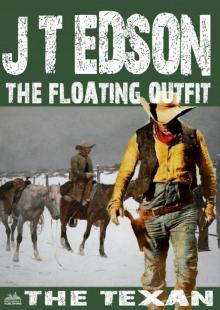 The Floating Outfit 46
The Floating Outfit 46 Dusty Fog's Civil War 11
Dusty Fog's Civil War 11 The Floating Outfit 61
The Floating Outfit 61 The Owlhoot
The Owlhoot Alvin Fog, Texas Ranger
Alvin Fog, Texas Ranger The Floating Outfit 34: To Arms! To Arms! In Dixie! (A Floating Outfit Western)
The Floating Outfit 34: To Arms! To Arms! In Dixie! (A Floating Outfit Western) The Floating Outfit 44
The Floating Outfit 44 Dusty Fog's Civil War 10
Dusty Fog's Civil War 10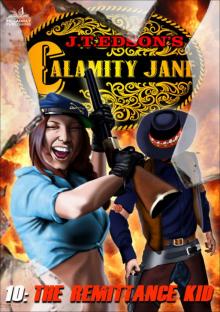 Calamity Jane 10
Calamity Jane 10 Cap Fog 4
Cap Fog 4 The Floating Outfit 51
The Floating Outfit 51 The Floating Outfit 50
The Floating Outfit 50 The Floating Outfit 49
The Floating Outfit 49 The Floating Outfit 10
The Floating Outfit 10 Apache Rampage
Apache Rampage The Floating Outfit 15
The Floating Outfit 15 Ranch War
Ranch War The Floating Outfit 11
The Floating Outfit 11 The Devil Gun
The Devil Gun Sacrifice for the Quagga God (A Bunduki Jungle Adventure Book 3)
Sacrifice for the Quagga God (A Bunduki Jungle Adventure Book 3) Comanche (A J.T. Edson Western Book 1)
Comanche (A J.T. Edson Western Book 1) The Floating Outfit 48
The Floating Outfit 48 Wacos Debt
Wacos Debt The Rebel Spy
The Rebel Spy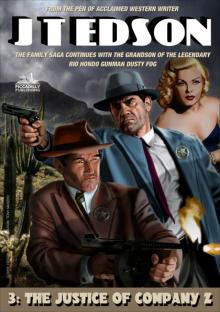 Cap Fog 3
Cap Fog 3 Trouble Trail
Trouble Trail Cold Deck, Hot Lead
Cold Deck, Hot Lead Rockabye County 4
Rockabye County 4 The Bullwhip Breed
The Bullwhip Breed Set Texas Back On Her Feet (A Floating Outfit Western Book 6)
Set Texas Back On Her Feet (A Floating Outfit Western Book 6)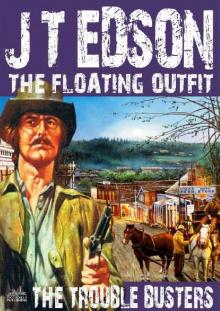 The Floating Outfit 25: The Trouble Busters (A Floating Outfit Western)
The Floating Outfit 25: The Trouble Busters (A Floating Outfit Western) Fearless Master of the Jungle (A Bunduki Jungle Adventure
Fearless Master of the Jungle (A Bunduki Jungle Adventure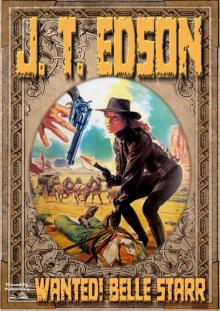 Wanted! Belle Starr!
Wanted! Belle Starr! The Big Hunt
The Big Hunt Running Irons
Running Irons The Floating Outfit 19
The Floating Outfit 19 You're in Command Now, Mr Fog
You're in Command Now, Mr Fog The Floating Outfit 27
The Floating Outfit 27 Texas Killers
Texas Killers Ole Devil and the Mule Train (An Ole Devil Western Book 3)
Ole Devil and the Mule Train (An Ole Devil Western Book 3) Bunduki and Dawn (A Bunduki Jungle Adventure Book 2)
Bunduki and Dawn (A Bunduki Jungle Adventure Book 2) The Fortune Hunters
The Fortune Hunters The Floating Outfit 12
The Floating Outfit 12 The Hide and Tallow Men (A Floating Outfit Western. Book 7)
The Hide and Tallow Men (A Floating Outfit Western. Book 7) Young Ole Devil
Young Ole Devil Slip Gun
Slip Gun The Drifter
The Drifter The Floating Outfit 45
The Floating Outfit 45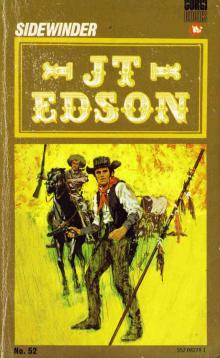 Sidewinder
Sidewinder The Ysabel Kid
The Ysabel Kid Waco 6
Waco 6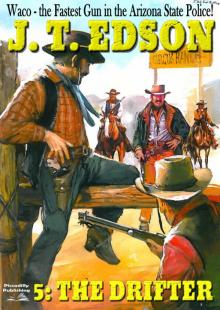 Waco 5
Waco 5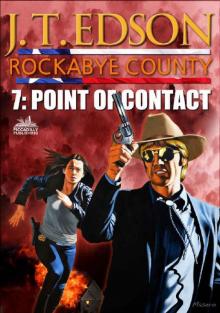 Point of Contact
Point of Contact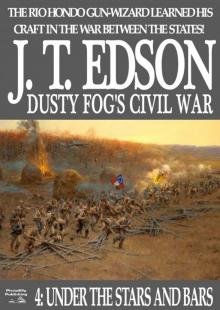 Under the Stars and Bars (A Dusty Fog Civil War Western Book 4)
Under the Stars and Bars (A Dusty Fog Civil War Western Book 4) The Floating Outfit 9
The Floating Outfit 9 Under the Stars and Bars
Under the Stars and Bars .44 Caliber Man
.44 Caliber Man The Floating Outfit 17
The Floating Outfit 17 Ole Devil at San Jacinto (Old Devil Hardin Western Book 4)
Ole Devil at San Jacinto (Old Devil Hardin Western Book 4) The Bloody Border
The Bloody Border A Horse Called Mogollon (Floating Outfit Book 3)
A Horse Called Mogollon (Floating Outfit Book 3) Waco 3
Waco 3 The Texan
The Texan The Floating Outfit 35
The Floating Outfit 35 Mississippi Raider
Mississippi Raider The Big Gun (Dusty Fog's Civil War Book 3)
The Big Gun (Dusty Fog's Civil War Book 3) Goodnight's Dream (A Floating Outfit Western Book 4)
Goodnight's Dream (A Floating Outfit Western Book 4) Waco 4
Waco 4 From Hide and Horn (A Floating Outfit Book Number 5)
From Hide and Horn (A Floating Outfit Book Number 5) The Floating Outfit 18
The Floating Outfit 18 Slaughter's Way (A J.T. Edson Western)
Slaughter's Way (A J.T. Edson Western) Dusty Fog's Civil War 7
Dusty Fog's Civil War 7 Two Miles to the Border (A J.T. Edson Western)
Two Miles to the Border (A J.T. Edson Western)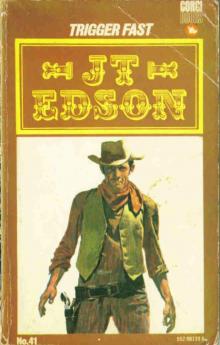 Trigger Fast
Trigger Fast Waco's Badge
Waco's Badge A Matter of Honor (Dusty Fog Civil War Book 6)
A Matter of Honor (Dusty Fog Civil War Book 6) The Half Breed
The Half Breed Bunduki (Bunduki Series Book One)
Bunduki (Bunduki Series Book One) Kill Dusty Fog
Kill Dusty Fog Get Urrea! (An Ole Devil Hardin Western Book 5)
Get Urrea! (An Ole Devil Hardin Western Book 5) Dusty Fog's Civil War 9
Dusty Fog's Civil War 9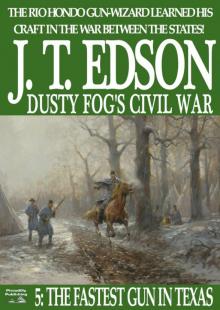 The Fastest Gun in Texas (A Dusty Fog Civil War Book 5)
The Fastest Gun in Texas (A Dusty Fog Civil War Book 5) Sagebrush Sleuth (A Waco Western #2)
Sagebrush Sleuth (A Waco Western #2) Quiet Town
Quiet Town Is-A-Man (A J.T. Edson Standalone Western)
Is-A-Man (A J.T. Edson Standalone Western) Rockabye County 5
Rockabye County 5 The Floating Outfit 14
The Floating Outfit 14 Cure the Texas Fever (A Waxahachie Smith Western--Book 3)
Cure the Texas Fever (A Waxahachie Smith Western--Book 3) The Floating Outfit 13
The Floating Outfit 13 The Road to Ratchet Creek
The Road to Ratchet Creek